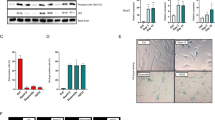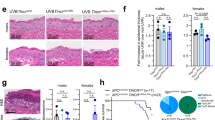Abstract
The small, proline-rich (SPR) genes consist of three subclasses closely linked on human chromosome 1, a region referred to as the epidermal differentiation complex. SPR genes consist of two exons, with the second exon containing the entire open reading frame. SPRs are expressed in all squamous tissues of the skin, scalp, foot pad, vaginal epithelia, and most of the epithelial lining of the digestive tract, including the lip, tongue, esophagus, and forestomach. Although SPR1 is absent in normal mucociliary epithelium of the respiratory tract, epithelia that undergo squamous differentiation in response to vitamin-A deficiency or to injury owing to exposure to environmental toxicants express SPR1. High levels of SPR1 are detected in various diseases and cancers of the skin or respiratory epithelia and in nonkeratinizing papillary adenocarcinomas. SPR expression can be regulated by transcriptional factors, by posttranscriptional factors, or by factors that affect SPR1 mRNA translation or protein turnover. Furthermore, regulation can be affected by the state of cell proliferation. The presence of SPR1 in most of these epithelia, and the absence of SPR3 in normal skin, suggest that these subclasses have distinct functions. Various approaches to the study of the cross-linked envelope (CE) components in identifying SPR1 and SPR2 and in suggesting that SPRs are one of the precursor proteins of the CE. However, expression of SPR1 in nonsquamous tissues and cell lines indicates a function not associated with squamous differentiation. Several studies have demonstrated that SPR1 antibodies react with nuclear proteins and that SPR1 is expressed in cells before entering the G0 phase of the cell cycle. Future studies should clarify the role of SPRs by modifying their contents in CE, and should identify SPR-associated proteins to clariy the cell growth-related role of SPR1.
Similar content being viewed by others
References
An, G., Huang, T.H., Tesfaigzi, J., Garcia, H.J., Ledbetter, D.H., Carlson, D.M., and Wu, R. (1992) An unusual expression of a squamous cell marker, small proline-rich protein gene, in tracheobronchial epithelium, differential regulation and gene mapping.Am J Respir Cell Mol. Biol. 7(1), 104–111.
Gibbs, S., Fijneman, R., Wiegant, J., van Kessel, A.G., van De Putte, P., and Backendorf, C. (1993) Molecular characterization and evolution of the SPRR family of keratinocyte differentiation markers encoding small proline-rich proteins.Genomics,16(3), 630–637.
Mischke, D., Korge, B., Marenholz, I., Volz, A., and Ziegler, A. (1996) Genes encoding structural proteins of epidermal cornification and S100 calcium-binding proteins form a gene complex (“epidermal differentiation complex”) on human chromosome 1q21.J. Invest Dermatol. 106(5), 989–992.
Backendorf, C., and Hohl, D. (1992) A common origin for cornified envelope proteins? [letter].Nat. Genet 2(2), 91.
Marvin, K.W., George, M.D., Fujimoto, W., Saunders, N.A., Bernacki, S.H., and Jetten, M.A. (1992) Cornifin, a cross-linked envelope precursor in keratinocytes that is down-regulated by retinoids.Proc Natl. Acad. Sci. USA 89, 11,026–11,030.
Austin, S.J., Fujimoto, W., Marvin, K.W., Vollberg, T.M., Lorand, L., and Jetten, A.M. (1996) Cloning and regulation of cornifin beta, a new member of the cornifin/spr family. Suppression by retinoic acid receptor-selective retinoids.J. Biol. Chem. 271(7), 3737–3742.
Kartasova, T. and van de Putte P. (1988) Isolation, characterization, and UV-stimulated expression of two families of genes encoding polypeptides of related structure in human epidermal keratinocytes.Mol. Cell Biol. 8(5), 2195–203.
Tesfaigzi, J., An, G., Wu, R., and Carlson, D.M. (1990) Induction in the expression of an unusual proline-rich protein by pig tracheal surface epithelial cells maintained in primary culture.Biochem Biophys. Res. Commun. 172(3), 1304–1309.
Smits, H.L., Floyd, E.E., and Jetten, A.M. (1987) Molecular cloning of gene sequences regulated during squamous differentiation of tracheal epithelial cells and controlled by retinoic acid.Mol. Cell Biol. 7(11) 4017–4023.
Koizumi, H., Kartasova, T., Tanaka, H., Ohkawara, A., and Kuroki, T. (1996) Differentiation-associated localization of small prolinerich protein in normal and diseased human skin.Br. J. Dermatol. 134(4), 686–692.
Hohl, D. de Viragh, P.A., Amiguet-Barras, F., Gibbs, S., Backendorf, C., and Huber, M. (1995) The small proline-rich proteins constitute a multigene family of differentially regulated cornified cell envelope precursor proteins.J. Invest. Dermatol. 104(6), 902–909.
Jarnik, M., Kartasova, T., Steinert, P., Lichti, U., and Steven, A. (1996) Differential expression and cell envelope incorporation of small proline-rich protein 1 in different cornified epithelia.J. Cell Sci. 109(Pt 6), 1381–1391.
Kartasova, T., Darwiche, N., Kohno, Y., Koizumi, H., Osada, S., Huh, N., Lichti, U., Steinert, P.M., and Kuroki, T. (1996) Sequence and expression patterns of mouse SPR1, Correlation of expression with epithelial function.J. Invest. Dermatol. 106(2), 294–304.
Kartasova, T., van, M. G., van P., Heerschap, H., and van de Putte, P. (1988) Novel protein in human epidermal keratinocytes, regulation of expression during differentiation.Mol. Cell Biol. 8(5), 2204–2210.
Owens, D.M., Zainal, T.A., Jetten, A.M., and Smart, R.C. (1996) Localization and expression of cornifin-alpha/SPRR1 in mouse epidermis, anagen hair follicles, and skin neoplasms.J. Invest. Dermatol. 106(4), 647–654.
Fujimoto, W., Nakanishi, G., Arata, J., and Jetten, A.M. (1997) Differential expression of human cornifin alpha and beta in squamous differentiating epithelial tissues and several skin lesions.J. Invest. Dermatol. 108(2), 200–204.
Fujimoto, W., Marvin, K.W., George, M.D., Celli, G., Darwiche, N., De Luca, L.M., and Jetten, A.M. (1993) Expression of cornifin in squamous differentiating epithelial tissues, including psoriatic and retinoic acid-treated skin.J. Invest. Dermatol. 101(3), 268–274.
Yaar, M., Eller, M.S., Bhawan, J., Harkness, D.D., DiBenedetto, P.J., and Gilchrest, B.A. (1995) In vivo and in vitro SPRR1 gene expression in normal and malignant keratinocytes.Exp. Cell. Res. 217(2) 217–226.
Abraham, J., Wang, S., Suzuki, H., Jiang, H., Rosenblum-Vos, L., Yin, J., and Meltzer, S. (1996) Esophagin cDNA cloning and characterization, a tissue-specific member of the small proline-rich protein family that is not expressed in esophageal tumors.Cell. Growth Differ. 7(7), 855–860.
Tesfaigzi, J., Th'ng, J., Wright, P.S., Hotchkiss, J.A., and Harkema, J.R. (1996) A small proline-rich protein, sPRR1, is up-regulated early during tobacco smoke-induced squamous metaplasia in rat nasal epithelia.Am. J. Respir. Cell Mol. Biol. 14, 478–486.
Tesfaigzi, J., Wright, P.S., Oreffo, V., An, G., Wu, R., Witschi, H., and Carlson, D.M. (1993) A small proline-rich protein regulated by vitamin A in tracheal epithelial cells is induced in lung tumors.Am J. Resp. Cell Mol. Biol. 9, 434–440.
Fornace, A.J. (1992) Mammalian genes induced by radiation; activation of genes associated with growth control.Annu. Rev. Genet. 26, 507–526.
Tesfaigzi, J., and Carlson, D.M. (1996) Cell cycle-specific expression of G0SPR in Chinese hamster ovary cells.Exp Cell Res 228, 277–282.
Fornace, A.J., Jr., Alamo, I., Jr., and Hollander, M.C. (1988) DNA damage-inducible transcripts in mammalian cells.Proc. Natl. Acad. Sci. USA 85(23) 8800–8804.
Fornace, A.J., Jr., Jackman, J., Hollander, M.C., Hoffman-Liebermann, B., and Liebermann, D.A. (1992) Genotoxic-stress-response genes and growth-arrest genes. gadd, MyD, and other genes induced by treatments eliciting growth arrest.Ann. NY Acad. Sci. 663, 139–153.
Ishida-Yamamoto, A., Kartasova, T., Matsuo, S., Kuroki, T., and Iizuka, H. (1997) Involucrin and SPRR are synthesized sequentially in differentiating cultured epidermal cells.J. Invest. Dermatol. 108(1), 12–16.
Lohman, F., Medema, J., Gibbs, S., Ponec, M., van, d.P.P., and Backendorf, C. (1997) Expression of the SPRR cornification genes is differentially affected by carcinogenic transformation.Exp. Cell Res. 231(1), 141–148.
Fischer, D.F., Gibbs, S., van De Putte, P., and Backendorf, C. (1996) Interdependent transcription control elements regulate the expression of the SPRR2A gene during keratinocyte terminal differentiation.Mol. Cell Biol. 16(10), 5365–5374.
Lohman, F.P., Gibbs, S., Fischer, D.F., Borgstein, A.M., van de Putte, P., and Backendorf, C. (1997) Involvement of c-JUN in the regulation of terminal differentiation genes in normal and malignant keratinocytes.Oncogene 14(13), 1623–1627.
An, G., Tesfaigzi, J., Chuu, Y.J., and Wu, R. (1993) Isolation and characterization of the human spr1 gene and its regulation of expression by phorbol ester and cyclic AMP.J. Biol. Chem. 268(15), 10,977–10,982.
Reddy, S.P., Chuu, Y.J., Lao, P.N., Donn, J., Ann, D.K., and Wu, R. (1995) Expression of human squamous cell differentiation marker, SPR1, in tracheobronchial epithelium depends on JUN and TRE motifs.J. Biol. Chem. 270(44), 26,451–26,459.
An, G., Tesfaigzi, J., Carlson, D.M., and Wu, R. (1993) Expression of a squamous cell marker, the spr1 gene, is posttranscriptionally down-regulated by retinol in airway epithelium.J. Cell Physiol. 157, 562–568.
Jetten, A.M., De Luca, L.M., Nelson, K., Schroeder, W., Burlingame, S., and Fujimoto, W. (1996) Regulation of cornifin alpha expression in the vaginal and uterine epithelium by estrogen and retinoic acid.Mol. Cell Endocrinol. 123(1), 7–15.
Gibbs, S., Backendorf, C., and Ponec, M. (1996) Regulation of keratinocyte proliferation and differentiation by all-trans-retinoic acid, 9-cis-retinoic acid and 1,25-dihydroxy vitamin D3.Arch. Dermatol. Res. 288(12), 729–738.
Tesfaigzi, J., and Carlson, D.M. (1996) Expression of the spr1 gene in cultured tracheal epithelial cells and its regulation by retinoids before and after confluence.J Cell Physiol 166(3), 480–486.
Saunders N.A., and Jetten, A.M. (1994) Control of growth regulatory and differentiation-specific genes in human epidermal keratinocytes by interferon gamma. Antagonism by retinoic acid and transforming growth factor beta 1.J. Biol. Chem. 269(3), 2016–2022.
Lever, W.F., and Schaumburg-Lever, G. (1990)in Histopatholgoy of the Skin, 7th ed., Lippencott, Philadelphia, PA, pp. 523–577.
Steinert, P.M., and Marekov, L.N. (1995) The proteins elafin, filaggrin, keratin intermediate filaments, loricrin, and small proline-rich proteins 1 and 2 are isodipeptide cross-linked components of the human epidermal cornified cell envelope.J. Biol. Chem. 270(30), 17,702–17,711.
Roop, D. (1995) Defects in the barrier.Science 267(5197), 474–475.
Steven, A.C., and Steinert, P.M. (1994) Protein composition of cornified cell envelopes of epidermal keratinocytes.J. Cell. Sci. 107(Pt 2), 693–700.
Baden, H., Kubilus, J., Phillips, S., Kvedar, J., and Tahan, S. (1987) A new class of soluble basic protein precursors of the cornified envelope of mammalian epidermis.Biochim. Biophys. Acta. 925(1), 63–73.
Greco, M.A., Lorand, L., Lane, W.S., Baden, H.P., Parameswaran, K.N., and Kvedar, J.C. (1995) The pancornulins, a group of small proline rich-related cornified envelope precursors with bifunctional capabilities in isopeptide bond formation.J. Invest. Dermatol. 104(2), 204–210.
Steinert, P.M. (1995) A model for the hierarchical structure of the human epidermal cornified cell envelope.Cell Death Diff. 2, 33–40.
Steinert, P.M., and Marekov, L.N. (1997) Direct evidence that involucrin is a major early isopeptide cross-linked component of the keratinocyte cornified cell envelope.J. Biol. Chem. 272(3), 2021–2030.
Robinson, N.A., Lapic, S., Welter, J.F., and Eckert, R.L. (1997) S100A11, S100A10, annexin I, desmosomal proteins, small proline-rich proteins, plasminogen activator inhibitor-2, and involucrin are components of the cornified envelope of cultured human epidermal keratinocytes.J. Biol. Chem. 272(18), 12,035–12,046.
Tesfaigzi, J., An, G., Wu, R., and Carlson, D.M. (1995) Two nuclear proteins in tracheal epithelial cells are recognized by antibodies specific to a squamous differentiation marker, spr1.J. Cell Physiol. 164, 571–578.
Zhan, Q., Lord, K.A., Alamo, I., Jr., Hollander, M.C., Carrier, F., Ron, D., Kohn, K.W., Hoffman, B., Liebermann, D.A., and Fornace, A.J., Jr. (1994) The gadd and MyD genes define a novel set of mammalian genes encoding acidic proteins that synergistically suppress cell growth.Mol. Cell Biol. 14(4), 2361–2371.
Author information
Authors and Affiliations
Rights and permissions
About this article
Cite this article
Tesfaigzi, J., Carlson, D.M. Expression, regulation, and function of the SPR family of proteins. Cell Biochem Biophys 30, 243–265 (1999). https://doi.org/10.1007/BF02738069
Issue Date:
DOI: https://doi.org/10.1007/BF02738069




